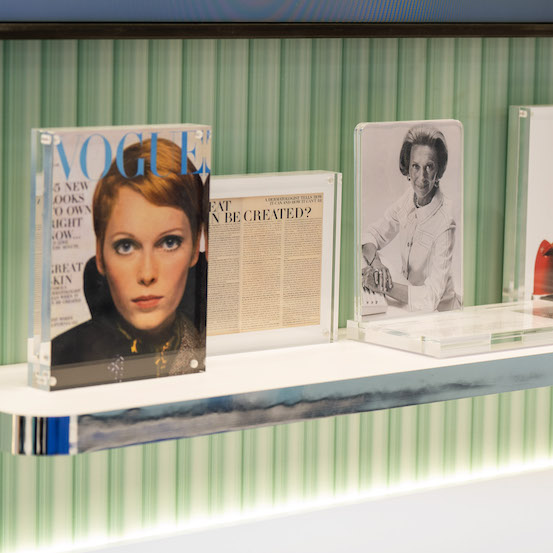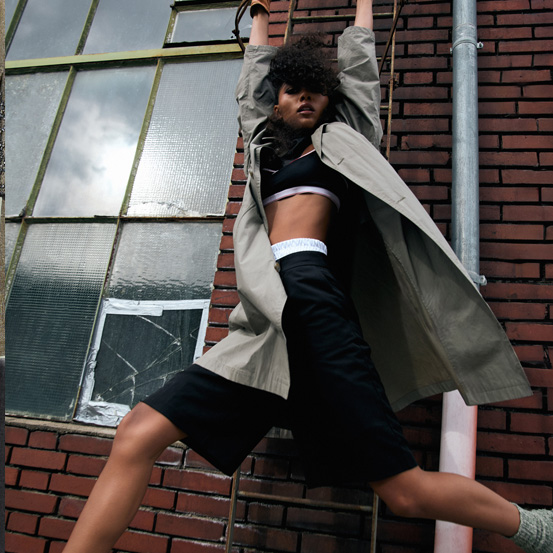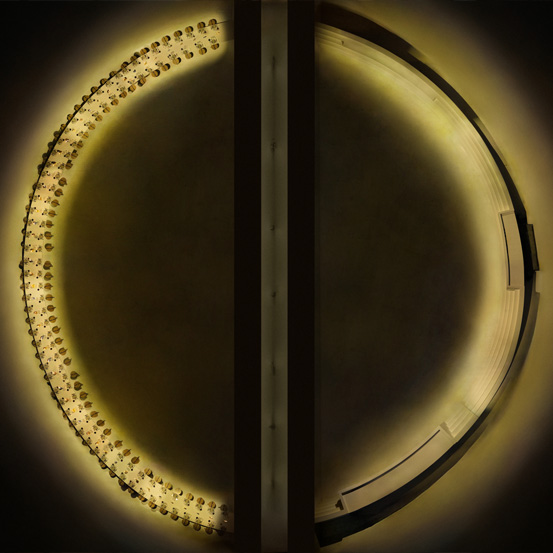Antwerp’s fashion museum, MoMu, presents the darkly romantic work of the mid-career Belgian designer.
The yellow fabric writhed like an uncontrollable animal as a team of four tried to keep it under control. “We just received it from Madonna this morning. There was a general strike in Belgium and it was stuck at customs,” Olivier Theyskens explained, recalling the moment, two decades ago, when, as a young and unknown designer, he had folded the Madonna dress in a big box and driven wildly through two red lights on Paris streets to get the dress on to a train and send it on its way to Los Angeles.
“We were just a team of friends, basically, and we had to sew 500 hooks and eyes by hand,” Olivier said, remembering how it felt to be chosen by a superstar at the age of 20, when he was barely on the Paris fashion radar. “There is also a second dress in black-coated jersey that Madonna wore when she sang ‘Frozen’ from the album ‘Ray of Light’,” Theyskens recalled.
By the time the grey light of Antwerp had faded into night, those two dresses sent by the American superstar had to be in place at MoMu, the Belgian fashion museum that is staging an exhibition of Theyskens work, “She Walks in Beauty” (until 18 March 2018). The unfolding story of the darkly romantic Theyskens encompasses his work for the historic Paris maisons, Rochas and Nina Ricci; then the affordable ready-to-wear label, Theory in New York; and finally the recent re-launch of his own brand.
Kaat Debo, MoMu’s director, chose the Belgian designer to close a chapter at the museum, which is about to undergo a two-year refurbishment. “If you look at Olivier’s career – especially at a time when the big houses change their creative directors so often – Olivier’s career has a very interesting past, Debo said. “He is 40 and started when he was 20,” she continued. “He is so young and has already spent half his life in fashion, so we can see his evolution from his own brand, and his DNA throughout.”
As well as the drama of Madonna’s travelling wardrobe; the vision of exquisite lace on vaporous Rochas bodices; and the final displays of recent outfits in the designer’s delicate colours with modern prettiness, another touching story in the exhibition comes from his latest Spring/Summer 2018 collection, which few international commentators saw because last month’s Paris Fashion Week schedule pitted Theyskens against the massive Saint Laurent show, timed to start on the hour with a twinkling Eiffel Tower.
I was fascinated by a glimpse of history on the floor of the museum. As I walked the rooms with Olivier and the curator, underfoot there were strokes of colour, shaded and smudged – traces of previous exhibitions, such as Antwerp designer Dries van Noten’s, whose installation and removal marks were purposely left behind by Debo as fashion memories.
For museums to bring fashion shows to life there have to be these glimpses of the past. And MoMu has done that so well for Theyskens, displaying not only the clothes – the subtle sensuality of satin slithering over skin and a spread of blood-red flowers taken from upholstery design – but also the designer’s drawings, so skilfully done that they are almost as effective as the videos of the shows. Set at the back of the displays, the clothes in motion are a welcome nod to the digital world and a vision of how the clothes looked on the body, while the drawings are exceptionally complete, each detail drawn in.
“Olivier is someone who is in different times at the same time,” said Karen Von Godtsenhoven, who curated this Antwerp show with Lydia Kamitsis from the Sorbonne in Paris. “He uses so many different influences,” Karen continued. “Although he was only at La Cambre [a Belgian fashion school] for a short time, his teacher said that Olivier was someone out of time, who was already very accomplished when he started as a student.”
“We think of him as a Belgian designer,” she explained, “but the Belgian touch is mostly in his atmosphere and colours. His use of materials and technique label him as a French designer.”
The Theyskens touch is, indeed, subtle in the way of Paris couture: a tiny bird created in feathers on an evening shoe; or the particular shades of the Nina Ricci years, from 2006-2009, when mud brown and apple green created an autumnal symphony. The fashion shows themselves rest in my memory, especially when young models, their bodies undulating inside silken dresses, walked a Ricci show in an open-ended tent in the Jardin des Tuileries in Paris, bringing nature inside from outside.
The Antwerp exhibition is chronological, starting with the first line of Lord Byron’s 1813 poem, “She walks in beauty, like the night”, hand-written on the walls by the designer, followed by his Autumn/Winter 1997-98 works of Gothic romance, played out mostly in black with the textures of lace, satin and silver embroidery turning black into a colour. Futurism-meets-historicism is a good way to describe the compelling melds of crinoline dresses with modern coats.
Another poetic sign from the designer is a line from Edgar Allen Poe: “There is no exquisite beauty… without some strangeness in the proportion.”
“It fits very well with the work, because Olivier is not a narrative designer; he is someone within his own world that stays consistent,” Karen said. “The best way to describe that, instead of using many references, is to have these literary interventions.”
To find the exquisite is to look at Theyskens work for Rochas and then Nina Ricci. The designer laughed at himself in retrospect. Without ever visiting Japan, he imagined fashion of the Far East, finishing with patterns and textures that included Monet flowers worked in lace and printed with watercolours for a mix of the historic and futuristic.
Olivier’s work in Paris was so compelling that I must admit to being less engaged by the ready-to-wear of the Theory years (2010-2014), although it shows a fresher, less historic way for the designer to explore his fashion vision. After the eerie colours and lush fabrics, the American interlude seems mundane, although perhaps important as a reality check for the designer.
A vast, 35-metre-long, subtly embroidered wedding gown for socialite Nell Diamond offers a pause before the “Fashion Now” section of the exhibition. In this room, the designer managed to put his life in a checkered coat “inspired by my Normandy roots and those flat lands, the girls of the village in French tartan and little boots”.
The exhibition ends, perhaps deliberately, with a question mark. Where will the Olivier Theysken’s woman “walk in beauty” now? The idea of a museum fashion show for a living designer is relatively new. The Yves Saint Laurent exhibition in New York’s Metropolitan Museum in 1983 was the first exploration of a fashion designer past and present. But presenting a designer at age 40 suggests a pause in his career, not an end.
There is something strange and compelling about Theysken’s work, made more so by the ripped ceiling and stains on the floor of a museum about to be uprooted, while fashion artworks will continue to be shown in various temporary locations, including the Maurice Verbaet Art Center in Antwerp (www.verbaet.com).
Theyskens’ vision extends to his own choice of photographers who have made the Rizzoli book accompanying the exhibition a work of art in itself. As Kaat Debo says, “Olivier Theyskens continually succeeds in parenting an image of fashion that is entirely his own and entirely up-to-date.”
But what is his future? Let’s hope there will be a second museum act as the designer’s career enters a new chapter."Olivier Theyskens: She Walks in Beauty" is at MoMu Antwerp until 18 March 2018; www.momu.be)
Most popular


Relacionados
.jpg)
Alice Trewinnard prepara-se para a GQ Night of the Year | Beauty Confessions
23 Nov 2024

.jpg)



